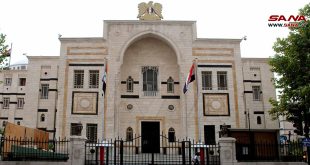Homs, SANA – The Great Mosque of al-Nuri is one of the prominent archaeological sites in Homs as it was the first mosque built in the city, featuring important aspects of Homs’ social and cultural history.
Originally, al-Nuri Mosque was, under the Roman Empire, the site of the city’s pagan temple for the sun god (El-Gabal), and later during the Byzantine phase of the Empire, the temple was converted into a church dedicated to Saint John the Baptist, then after Islam entered Syria, one-fourth or half of the church was transformed into the Friday Mosque.
During the reign of Zengid sultan Nur al-Din, between 1146 and 1174, much of the modern structure was built and thus the name “al-Nuri” was attributed to him.

The Mosque, as the historical researcher Amer Jawad al-Sebaei illustrated in a lecture delivered at the Arab Cultural Center in Homs, is situated at the center of the commercial area in Homs and surrounded by a part of the Old Homs wall, the roofed market, al-Hesba market and al-Hamidiyeh Street-all of a historic value-which makes the mosque an integral part of the cultural and religious heritage of the city.
The body structure of the Great Mosque of al-Nuri is large and rectangular and inside the mosque is courtyard of the same shape that includes a raised terrace along the wall, possibly representing a part of the podium on which the cella of the pagan temple would have stood.
Other independent structures in the courtyard include a heavily decorated basalt basin, perhaps being an old sarcophagus. Columns with Corinthian capitals line the wall, some of which are clearly of Roman origin.
The mihrab (pulpit) of the mosque contains remnants of mosaics in its arch while the main entrance to the mosque is arched, decorated with black and white stone, and carved with Arabic inscriptions on either side.
What adds to the mosque’s great historical importance, according to al-Sebaei, is its roof which is based on huge granite pillars remaining from the pagan temple of the sun god. He noted that after restoring the mosque’s roof in 1278 after Hijra (Prophet Muhammad’s migration), only the huge walls were left of the temple.
The mosque, the researcher stated, sums up Homs’ history, calling for forming a historical, engineering and scientific committee to study, restore and rehabilitate this building and carry out excavations to uncover the historical stages it passed through starting from the Pagan into Christianity then throughout the Islam period.
Reem/H.Said
 Syrian Arab News Agency S A N A
Syrian Arab News Agency S A N A




